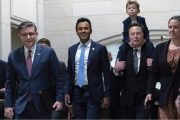
Republican John Cox of San Diego County in California appears to have the best chance of any GOP candidate for governor to win a spot on the ballot for the general election in November. Cox (shown) is picking up 10 percent of the vote in a recent poll by the Los Angeles Times, among the 27 candidates on the ballot for the June 5th primary.
In most states, primary elections are held to determine which Republican candidate will face which Democratic candidate, along with Independents and the nominees of other political parties, in the general election. With California’s system — sometimes referred to as a “jungle primary” — all candidates, regardless of political party, appear on the primary ballot. If no candidate then garners a majority of the vote, the top two vote-getters will face-off in the general election.
While 10 percent does not appear to be a huge portion of the vote, considering that there are 27 candidates and 39 percent of the voters are said to be undecided, that amount (along whatever voters he can pick up among those currently undecided) gives Cox a good shot to finish second in the race. It is also double the five percent amount that fellow Republican Travis Allen, a state assemblyman from Huntington Beach, picked up in the poll.
Governor Jerry Brown is term-limited and is not able to run again, leaving Lieutenant Governor Gavin Newsom, a strong liberal, as the most likely first-place finisher in the primary. Newsom had 21 percent of the vote in the poll.
The Democrat that Cox will most likely have to beat out in the primary to face Newsom in the general election is Antonio Villaraigosa. Villaraigosa, of Los Angeles County, had 11 percent in the poll, and while he is doing better among Hispanic voters than Newsom, he is not doing as well as he would like.
The Jungle Primary system can sometimes produce odd results, such as two Democrats or two Republicans in the general election. In other cases, the system can produce two candidates who, because of the unusually low percentages needed to advance to the general election, most likely could not have won an actual primary consisting of only primary party members and voters. For example, several years ago in Louisiana, the jungle primary used there produced a former official with the Ku Klux Klan (David Duke) and a former governor (Edwin Edwards), who had previously been indicted.
In the general election, Louisiana voters then had a choice between “the crook,” as Edwards was often called, and “the bigot,” as Duke was called. In the end, “the crook” won, but later went to prison.
The situation in California appears to be nothing that extreme, but their jungle primary has produced its own interesting strategies. For Newsom, he apparently would prefer to face Cox, the Republican, in the heavily Democrat state, rather than fellow Democrat Villaraigosa. Because of that, Newsom is directing his fire more at Villaraigosa, rather than Cox. What Newsom has said about Cox so far probably only serves to reinforce his chances of winning Republican votes, such as mentioning Cox’s support for gun rights. Villaraigosa, on the other hand, because he is needing to finish ahead of Cox, is directing more campaign salvoes at Cox, rather than front-runner Newsom, even referring to him as a Democrat in disguise — apparently to reduce Cox’s support among Republicans.
“It’s very volatile for second place,” stated Bob Shrum, a former Democratic operative. “It seems very likely that this is a contest between Villaraigosa and Cox at this point. Other people do not seem to have made substantial progress.”
Cox seems to have overcome the fact that he did not vote for Donald Trump in the 2016 presidential election, instead casting his ballot for Libertarian hopeful Gary Johnson. Yet President Trump jumped into the race late last week, throwing his support to Cox: “California finally deserves a great Governor, one who understands borders, crime and lowering taxes. John Cox is the man — he’ll be the best Governor you’ve ever had…. Make California Great Again!”
Cox has embraced both Trump’s endorsement — saying his vote for Johnson was a mistake — and Trump’s position on immigration, calling for an end to California’s status as a “sanctuary state” and issuing a new series of political ads trumpeting the Trump endorsement. This should help push Cox into the top two of the primary, but Trump’s support could be more problematic in the general election, since Trump is pulling less than 30 percent approval in polling among all voters.
Still, Cox is on the majority side in a poll of California voters, with 51 percent favoring the repeal of gas taxes and vehicle license fees. With a repeal vote on the November ballot, this would appear to improve Cox’s chances in a face-off with Newsom, who favored the tax hikes.
Gone are the days when a succession of Republican governors — Ronald Reagan, Pete Wilson, George Deukmejian, Jr. — won victories in the state. With the rising tide of immigration (which Governor Wilson warned about), no Republican since then has come close to winning the governorship except of course actor Arnold Schwarzenegger, who was not much of a Republican.
While still a long shot, were Cox to make the general election and actually win, the dynamics of presidential politics for 2020 would be dramatically altered.
Photo of John Cox: AP Images



